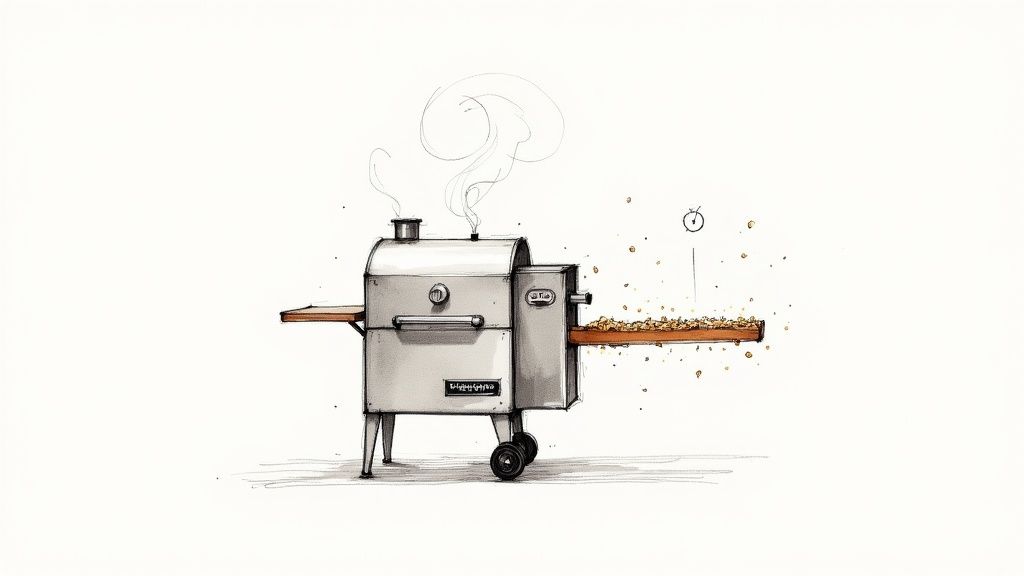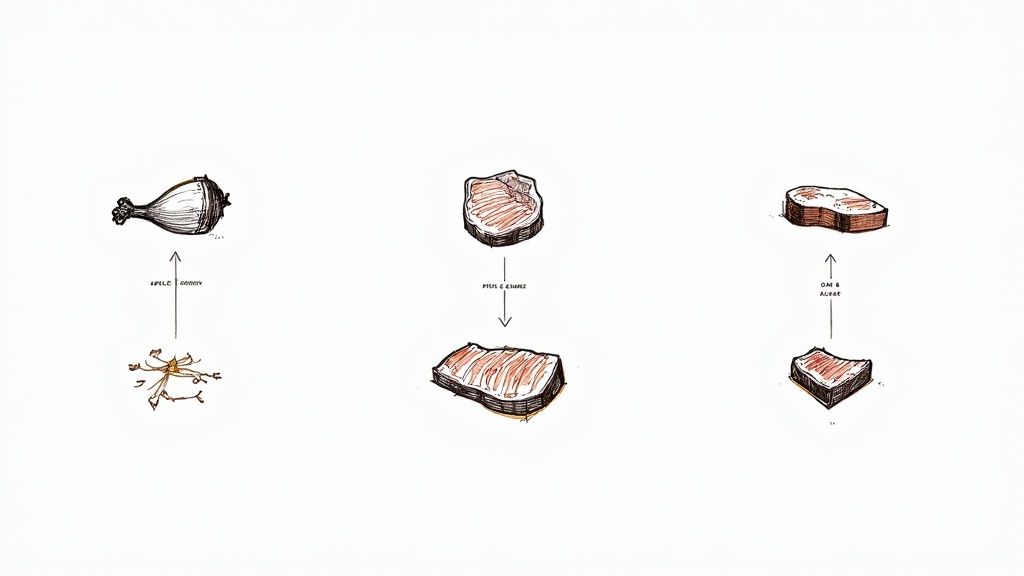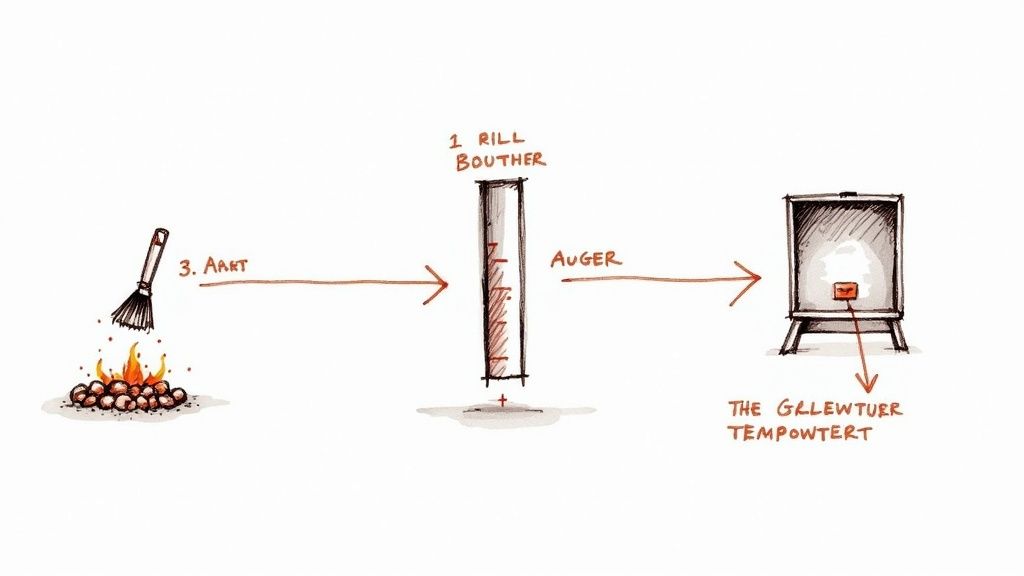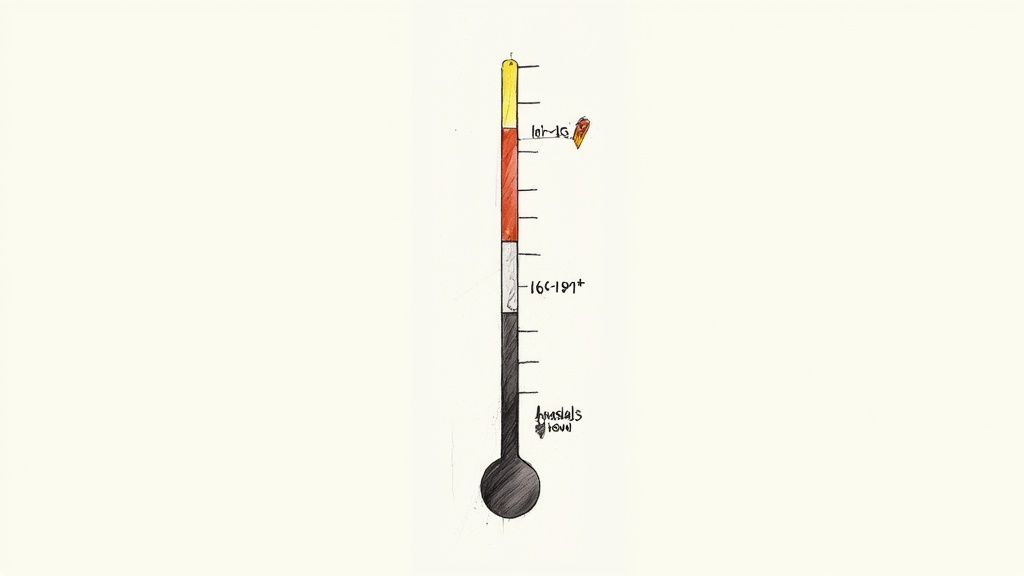A Modern Guide to BBQ with Wood Pellets
Ever wondered why so many BBQ lovers are making the switch to pellets? It's simple, really. You get that authentic, wood-fired flavour but with the dead-easy convenience of your kitchen oven.
BBQ with wood pellets gives you the best of both worlds: deep, smoky notes for those epic low-and-slow cooks, plus the high heat you need for a perfect sear. This guide will show you exactly how to use them to get incredible results.
Why Wood Pellets Are Changing Backyard BBQ
Forget babysitting a charcoal fire or fiddling with gas knobs. Pellet grills do the hard work for you. An automated auger feeds real hardwood pellets—made with no added crap—into a fire pot, holding whatever temperature you set with pinpoint accuracy. This means you can focus on the flavour, not the fire.

This level of control unlocks a whole new world of cooking in your own garden. Being able to smoke a brisket for hours at 107°C and then crank it up to 260°C to sear a steak—all on the same machine—is an absolute game-changer.
It’s All About Consistency and Flavour
What really makes pellet grilling so good is that it blends real, smoky flavour with modern simplicity. The key benefits are huge:
- Unmatched Temperature Control: Digital controllers keep your set temperature locked in, usually within just a few degrees. Your food cooks evenly, every single time.
- Authentic Wood-Fired Taste: You're burning 100% real hardwood, which infuses your food with a genuine smoky flavour you just can't get from a gas grill.
- Incredible Versatility: You can smoke, roast, bake, braise, and grill. It’s not just a BBQ; it’s an entire outdoor kitchen in one bit of kit.
At its heart, pellet grilling is about making incredible BBQ achievable for everyone. It gets rid of the steep learning curve of old-school smokers but delivers results that will impress even the most hardcore pitmaster.
The secret to getting the most out of your pellet grill is simple: pair quality fuel with quality seasonings. When you start with a foundation of premium, clean-burning wood pellets, you guarantee a pure smoke flavour. Combine that with rubs featuring authentic cultural flavours, and you'll create layers of flavour that take every meal to the next level.
Matching Wood Pellet Flavours to Your Food
Think of your wood pellets as the very first layer of flavour you build in any cook. They’re so much more than just fuel. Choosing the right wood is like a chef picking the perfect herb—it sets the entire tone for what comes off the grill. The whole point of using BBQ with wood pellets is to create a perfect harmony between the smoke and the meat, not to completely overpower it.
This is where knowing your wood profiles becomes a game-changer. Every type of wood brings its own unique character to the party, and getting the match right can turn a simple dish into something genuinely special.

Mild and Fruity Woods
When you're dealing with more delicate proteins like chicken, fish, and certain cuts of pork, you need a smoke that whispers, not shouts. This is where fruitwoods really shine.
- Cherry: Known for its light, sweet, and fruity smoke, it gives poultry and pork a stunning dark mahogany colour. It’s a brilliant choice for building up complex flavour layers without being too aggressive.
- Apple: Probably one of the mildest smoking woods out there, apple delivers a subtle sweetness that’s a classic match for pork, especially ribs and loin. It’s also fantastic with chicken.
How to use it: For chicken thighs, pat them dry, lightly coat with oil, and generously season with a rub that complements the sweet smoke. A perfect example is the Chipotle Cowboy Chicken Rub; its gentle warmth works in perfect harmony with apple or cherry smoke. Grill at around 175°C until cooked through for a smoky, flavourful weeknight meal.
For a full breakdown of different pellet options, our comprehensive Ninja Woodfire pellet guide offers even more detailed pairings and tips.
Strong and Bold Woods
Now, when you’re tackling the big boys—beef brisket, a hefty lamb shoulder, or a rack of beef ribs—you need smoke with enough backbone to stand up to those rich flavours.
- Hickory: This is the classic, quintessential BBQ smoke. It’s strong, has an almost bacon-like quality, and brings a slight sweetness. It’s the go-to for pork shoulders and ribs for a reason.
- Mesquite: The boldest of the bunch, without a doubt. Mesquite kicks out a powerful, earthy smoke with an intense flavour that's not for the faint of heart. It’s a favourite in Texas for beef, but be warned: a little goes a very long way.
These powerhouse woods demand equally robust seasonings. A generous coating of the Revolution Beef Rub on a brisket before it hits the hickory smoke is how you build that iconic, deeply savoury bark every pitmaster dreams of.
Pro Tip: Don't be afraid to get creative and mix your pellets. A classic move is to blend a strong wood like hickory with a milder one like apple. This lets you create a custom smoke profile that's all your own, balancing those big, bold notes with something a little softer for a more rounded flavour.
The All-Rounder Woods
Sometimes you just need a dependable, middle-of-the-road option that plays nicely with almost everything. Oak and alder are the versatile workhorses of the pellet world.
- Oak: A bit stronger than cherry but lighter than hickory, oak gives you a classic, medium-bodied smoke. It's fantastic for beef and lamb but won’t steamroll more delicate things like poultry.
- Alder: Known for its very light, delicate profile with a hint of sweetness, alder is the traditional wood for smoking salmon and other types of fish.
No matter what you choose, the most important rule is to always use 100% natural hardwood pellets. Stay away from pellets bulked out with fillers or binding agents. They can create a bitter smoke and cause your temperatures to swing wildly. For a clean burn and pure flavour every time, the Smokey Rebel wood pellet collection gives you the premium foundation your cook deserves.
Wood Pellet and Rub Pairing Guide
To make things even easier, here's a quick reference chart to help you match your pellet flavours and rubs with different foods. Getting these combos right is the secret to next-level results.
| Wood Pellet Type | Flavour Profile | Best Paired With | Recommended Smokey Rebel Rub |
|---|---|---|---|
| Apple | Mild, subtly sweet, fruity | Pork (ribs, loin), chicken, vegetables | Hickory Hog Pork Rub |
| Cherry | Mild, sweet, slightly tart | Chicken, pork, beef, lamb (great colour) | Cherry Force BBQ Rub |
| Hickory | Strong, bold, bacony, savoury | Pork (shoulder), beef (ribs), bacon | Hickory Hog Pork Rub |
| Oak | Medium, classic smoky, balanced | Beef (brisket), lamb, sausages | Revolution Beef Rub |
| Mesquite | Intense, earthy, powerful | Beef (brisket, steak), game meats | SPG (Salt, Pepper, Garlic) |
| Blends | Varies (often balanced & complex) | All-purpose (depends on the blend) | Match to the dominant wood or use an all-rounder like SPG as a base layer |
Use this guide as a starting point, but remember the best part of BBQ is experimenting to find out what you like best. Fire up the grill and have fun with it
Your Pre-Cook Ritual for Flawless Results
A truly great BBQ session starts long before any food hits the grates. It’s all about nailing a few simple, consistent habits that set you up for a flawless cook every single time. Think of it as laying the groundwork for flavour—a small investment of time that pays off with perfectly cooked food and a much less stressful experience.

This pre-cook ritual isn’t complicated. In fact, its entire purpose is to prevent complications later on, ensuring your pellet grill runs like a dream from start to finish.
Setting the Stage for Success
Before you even think about hitting the 'on' switch, a couple of quick checks are non-negotiable. These simple steps are your best defence against common problems like wild temperature swings or ignition failures, which can derail your cook before it even gets going.
First up, always check your fire pot. This is where the magic happens, but leftover ash from your last cook can smother the hot rod. That means a failed ignition or, worse, a fire that dies out mid-cook. A quick clear-out with a small brush or a vac ensures a clean, efficient burn.
Next, make sure your hopper is topped up with fresh, dry Smokey Rebel wood pellets. There’s no bigger nightmare for a pitmaster than running out of fuel halfway through a long smoke. Always start with more than you think you’ll need.
A clean fire pot and a full hopper are the two pillars of a reliable pellet grill cook. Skipping these simple checks is the most common cause of temperature problems.
Once those basics are sorted, you're ready to power on the grill. A crucial step for a lot of models is priming the auger. This just means running the auger for a minute or two to get a steady stream of pellets feeding into the fire pot before the hot rod kicks in. It’s the secret to a quick, robust ignition.
The Importance of a Full Preheat
Now for the final piece of the puzzle: patience. It’s so tempting to throw your food on the second you see smoke, but a full and proper preheat is essential for an even cook. Don't skip it.
Here’s a simple start-up sequence I always follow:
- Ignition and Smoke: Turn the grill on to its 'smoke' or lowest setting, but keep the lid open. Within a few minutes, you'll hear the fan whirring and see smoke start to billow out. That’s your pellets igniting.
- Establish the Fire: Wait until that initial heavy, thick smoke thins out and you hear the signature "roar" of the fire properly catching. Now you can close the lid.
- Set and Stabilise: Set your target cooking temperature and just walk away. Give the grill a good 15-20 minutes to preheat and stabilise completely. This isn't just about heating the air; it's about getting the heavy metal parts—the grates, the deflector plate—up to temperature to create a consistent thermal mass.
Following this process ensures the entire cooking chamber is at a stable, even temperature, killing off hot spots and giving you a perfect cooking surface. Master this simple ritual, and you'll have the confidence to tackle any recipe, knowing your grill is ready to perform.
Dialing in the Perfect Temperature for Any Dish
This is where pellet grills really come into their own. Forget the guesswork of charcoal; we're talking about precision temperature control. Once you get the hang of the different heat zones, you can cook anything from a delicate bit of fish to a monster ribeye, and get it spot on every time.
It all boils down to three main cooking ranges. Think of them as gears on your grill, each one designed for a specific job. Nailing which one to use is the secret to taking your BBQ with wood pellets from just 'good' to properly memorable.

The Low and Slow Zone for Ultimate Tenderness
This is the heartland of proper BBQ. The low-and-slow range, sitting between 107°C and 135°C (225-275°F), is where tough, collagen-heavy cuts of meat become something else entirely. That gentle, consistent heat slowly breaks down all the connective tissue and renders the fat, leaving you with incredibly juicy, tender meat.
This is your go-to zone for:
- Pulled Pork: For the ultimate seasonings for bbq pulled pork, cover a pork shoulder in our Hickory Hog Pork Rub, and let it smoke at 110°C for 8-10 hours until it shreds easily with a fork.
- Beef Brisket: The undisputed king of low-and-slow. Brisket absolutely needs this long, slow cook to become moist and packed with flavour.
- Ribs: Whether you're a pork or beef rib fan, this slow rendering process is what gets that meat to pull cleanly from the bone.
The Mid-Range for Roasting and Baking
Need to cook things a bit quicker but still want that authentic wood-fired flavour? The mid-range of 160°C to 190°C (325-375°F) is your sweet spot. You can basically treat your grill like a fan oven, but with the massive bonus of smoke. It's ideal for getting crispy skin while keeping the inside perfectly cooked.
Here’s a practical example for perfect BBQ chicken: Pat a whole chicken dry and season it generously with the Chipotle Cowboy Chicken Rub. Roast it at 180°C until the internal temperature reaches 74°C. The result is juicy meat with golden, crispy skin.
High Heat for Searing and Grilling
Right, this is for when you crave that deep, savoury crust and classic grill marks. It’s time to crank it up. The high-heat zone, anywhere from 230°C (450°F) and above, is purely for searing. That intense, direct heat kicks off the Maillard reaction—the chemical process that gives grilled food that incredible, rich flavour.
This is steak night territory. A thick-cut ribeye, hit with a bold seasoning like the Revolution Beef Rub, only needs a few minutes per side at this temp to build a perfect crust while staying pink and juicy inside. It's also brilliant for burgers, lamb chops, and quick-cooking veg like asparagus or peppers.
Crucial Tip: Ditch the timer and cook to temperature. A reliable digital meat probe is the single most important tool for guaranteeing your meat is cooked perfectly, whether that's a medium-rare steak or a fully rendered pork butt.
Especially with the unpredictable UK weather, keeping your temperature stable can be a real challenge. A simple insulated grill blanket can be a game-changer in the colder months. It helps your grill hold a steady temperature without hammering through pellets, letting you cook with precision all year round.
Pro Techniques to Take Your Pellet Grill BBQ to the Next Level
Once you've got the hang of your pellet grill's temperature, you can start playing with some of the techniques the pros use. These aren't complicated secrets, just small, deliberate tweaks that make a huge difference to flavour and texture when you’re doing a BBQ with wood pellets.
Master the Smoke Setting
Most pellet grills come with a dedicated 'Smoke' setting. This is usually the lowest temperature your grill will run at, often somewhere between 82-107°C, and it's your best friend for building deep flavour. At these low temps, the pellets smoulder away rather than burning hot and fast, creating a much thicker, more flavourful smoke.
A classic pitmaster move is to start your cook on this setting for the first hour or two. Think of it as a "smoke bath" for the meat. The cold surface of the meat is way more receptive to smoke, so this initial blast lays down an incredible smoky foundation. After that, you can crank the heat up to your target cooking temperature to get the job done.
Beating the Dreaded Stall
If you've ever tackled a big cut like a pork butt or brisket, you've probably met "the stall." It's that frustrating point, usually around 65-75°C, where the internal temperature of the meat just stops climbing for what feels like an eternity. It's a completely natural process caused by evaporative cooling, but it can test your patience.
To power through it, pitmasters turn to a trick known as the "Texas Crutch." It’s simple but effective:
- Smoke the meat unwrapped until it hits the stall.
- Pull it off the grill and wrap it tightly in either foil or, even better, butcher paper.
- Get it back on the grill to finish cooking.
That simple wrap traps moisture, creating a steamy environment that helps the meat push right through the stall and on to tenderness. You can see this technique in action in our comprehensive guide on how to smoke a brisket.
Building Epic Bark and Keeping Things Juicy
Two more simple tricks that pay massive dividends are using a water pan and spritzing.
Just stick a heat-proof pan of water inside your grill. This adds humidity to the cooking chamber, which does two things: it stops the meat from drying out, and it helps the surface stay moist. A moist surface attracts more smoke particles, leading to a better smoke ring and deeper flavour.
Spritzing is just lightly misting your meat every hour or so with a liquid like water, apple juice, or apple cider vinegar. This also keeps things from drying out and is absolutely key to building that beautiful, dark, and flavourful crust we all crave, known as the "bark."
These are the kinds of techniques that separate good BBQ from great BBQ. They’re subtle adjustments that give you real control over moisture, smoke, and texture, helping you turn out consistently amazing food every time you fire up the grill.
This focus on authentic flavour is why so many people are elevating their outdoor cooking game. Pellet grills, with their blend of convenience and real wood smoke, are at the forefront of this movement, making it easier than ever for home cooks to produce truly exceptional food.
FAQs: Your Top Pellet Grill Questions, Answered
Getting started with a new piece of kit always brings up questions. Here are quick, practical answers to some of the most common queries we hear from people new to BBQ with wood pellets.
Can I use any wood pellets in my BBQ grill?
Absolutely not. You must use food-grade wood pellets made specifically for BBQing. Heating pellets often contain softwoods, glues, and chemicals that are unsafe for cooking and can damage your grill. Always stick to 100% hardwood pellets from a trusted brand like the Smokey Rebel wood pellet collection to ensure clean smoke and pure flavour.
How do I get a better smoke ring?
The key is starting low and slow. Use your grill's lowest 'Smoke' setting (around 82-107°C) for the first 1-2 hours of the cook. A cold, moist meat surface absorbs smoke best, which helps form a more pronounced smoke ring. Keeping a water pan in the grill for added humidity also helps.
My pellet grill isn't producing much visible smoke. Is it working correctly?
Yes, this is normal and actually a good sign. Pellet grills are designed for efficient combustion, which produces a thin, almost invisible "blue smoke." This is the ideal smoke for flavouring food without making it taste bitter. If you want a more intense smoke flavour, start your cook on the lowest setting or use a stronger wood like hickory or mesquite.
What's the best way to store wood pellets?
Keep them dry. Moisture is the enemy of wood pellets, causing them to swell and disintegrate, which will clog your grill's auger. Store them indoors in a sealed, airtight container, like a plastic bucket with a secure lid, to protect them from humidity and ensure they're ready for your next cook.
At Smokey Rebel, we believe amazing flavour starts with the right foundation. All our rubs, from authentic cultural blends to BBQ classics, come in craft can packaging and contain no added crap. Whether you’re experimenting with smoke profiles or hunting for the perfect seasoning, we’ve got your back. Check out our Build Your Own Bundle and create a custom flavour kit that’s perfect for your next BBQ adventure.
Join our Mailing List
Sign up and get Smokey Rebel Recipes + weekly recipes straight to your inbox!
Recent articles
Slow Cooked Shin Beef Recipes For Tender Family Dinners
Discover easy slow cooked shin beef recipes with rich flavours, melt-in-your-mouth texture, and practical tips to elevate your weeknight family...
Read moreUnforgettable Meals for Christmas Without The Stress
Discover incredible meals for Christmas with our guide to festive recipes, menu planning, and tips for a memorable, stress-free holiday...
Read more10 Flavour-Packed Vegetarian Meals for Christmas Dinner in 2025
Searching for unforgettable vegetarian meals for Christmas dinner? Discover 10 show-stopping recipes, from Mushroom Wellington to Cauliflower Steaks.
Read more


